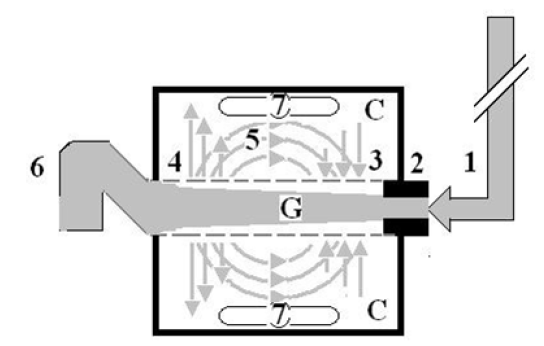Letter to Editor 
 Creative Commons, CC-BY
Creative Commons, CC-BY
New Theory on THE Capillary Physiology Based on 40-years Research Experience
*Corresponding author: Ahmed NM Ghanem, Consultant Urologist Surgeon- Retired Independent Investigator & Scientist, Free Lance Author, Dreamer & White Revolutionary, 5 Wroughton Terrance, London, NW4 4LE, Tel: 0044 (0) 7863705922.
Received: October 15, 2022; Published: October 18, 2022
DOI: 10.34297/AJBSR.2022.17.002336
Letter to Editor
Professor Starling proposed his hypothesis on the capillary interstitial fluid transfer in 1886 [1] and later in 1896 [2] in which fluid filtration is attributed to the hydrostatic pressure and absorption to the oncotic pressure of plasma proteins. It became a law after 1948 as based on a study in which there was an experimental error based on a misconception [3] that elevating arterial and venous pressures elevate the capillary pressure, which is true for venous pressure but not true for arterial pressure as based on the common observation that a rise in venous pressure causes oedema but hypertension never does. Substantial evidence currently exists to demonstrate how the capillary works in providing fluid with oxygen and nutrients to the interstitial fluid (ISF) space as well as remove the waste products at rest and exercise when the demand for oxygen is greater. It has been proven beyond any doubt that Starling’s law is in fact wrong on both of its forces and there are 21 reasons to affirm that [4]. There is new substantial evidence in both physics and physiology to prove Starling’s law is wrong and the correct replacement is the hydrodynamic of the G tube [5,6] (Figure 1). I have achieved 13 new scientific discoveries in physics, physiology, and medicine, [7], that precisely prove the correctness of this new theory on capillary physiology. The received knowledge and understating of capillary physiology are reported in this article [8]. Here I summarize the new evidence based on my 40-years of research work and reports.
The hydrodynamics of the porous narrow orifice tube (G) akin to the capillary ultrastructure with precapillary sphincter [9] and wide pores in its wall [10] provide the correct replacement for Starling’s law [5,6]. As the Figure 1 shows the fluid passing through the G tube with a chamber around it akin to capillary with its surrounding ISF space runs in a circulatory fashion with the fluid in the surrounding chamber running in an opposite direction to the flow in lumen. A rapid dynamic magnetic field like circulation between fluid in the lumen and the surrounding chamber is created [5]. The proximal akin to arterial pressure creates negative pressure gradient on the wall of the G tube with maximum negativity near the inlet and turns positive near the exit that creates net negative pressure in the surrounding chamber akin to ISF space. Adding fine tea leaves that are smaller than the pore to the circulatory fluid shows only a small amount goes to the surrounding chamber which is akin to plasma protein having higher concentration in the circulating blood than in the ISF space.
The tree branching law (TBL) corrects two widely received misconception on capillary physiology. This TBL states that “The tree trunk gives rise to branches that has a total cross section areas less than its own” [11]. Every branch of the tree becomes a trunk for its own branches. The law applies to both green trees and the red tree of the aorta and blood vessels. This TBL corrects 2 widely received misconceptions on capillary physiology concerning its cross-section areas and the blood speed in the capillary lumen [8]. This new theory is a firm foundation for the new scientific basis that should govern fluid therapy in shock resuscitation [12]. The physiological proof that the capillary works as G tube not Poiseuille’s tube has also been reported [13]. The result of this study indicates that the capillary works as the G tube not the Poiseuille’s tube.
Physiologist, physicians particularly anaesthetists and surgeons should become aware and understand that this new theory will help to save hundreds of thousands of patients being unnecessarily killed by ARDS every year all over the world. The “fluid creep” that occur during shock resuscitation of the critically ill and surgical patients being misled by Starling’s law [14] is responsible for that [15]. The editor of top journal has a grand role of spreading this new knowledge.

Figure 1:It shows a diagrammatic representation of the hydrodynamic of G tube based on G tubes and chamber C seen in (Figure 5). This
37-years old diagrammatic representation of the hydrodynamic of G tube in chamber C is based on several photographs some are shown
here. The G tube is the plastic tube with narrow inlet and pores in its wall built on a scale to capillary ultra-structure of precapillary sphincter
and wide inter cellular cleft pores, and the chamber C around it is another bigger plastic tube representing the interstitial fluid space to form the
G-C apparatus. The diagram represents a capillary-ISF unit that should replace Starling’s law in every future physiology, medical and surgical
textbooks, and added to chapters on hydrodynamics in physics textbooks. The numbers should read as follows:
1. The inflow pressure pushes fluid through the orifice.
2. Creating fluid jet in the lumen of the G tube**.
3. The fluid jet creates negative side pressure gradient causing suction maximal over the proximal part of the G tube near the inlet that sucks
fluid into lumen.
4. The side pressure gradient turns positive pushing fluid out of lumen over the distal part maximally near the outlet.
5. Thus, the fluid around G tube inside C moves in magnetic field-like circulation (5) taking an opposite direction to lumen flow of G tube.
6. The inflow pressure 1 and orifice 2 induce the negative side pressure creating the dynamic G-C circulation phenomenon that is rapid,
autonomous, and efficient in moving fluid and particles out from the G tube lumen at 4, irrigating C at 5, then sucking it back again at 3,
7. Maintaining net negative energy pressure inside chamber C.
**Note the shape of the fluid jet inside the G tube (Cone shaped), having a diameter of the inlet on right hand side and the diameter of the exit at
left hand side (G tube diameter). I lost the photo on which the fluid jet was drawn, using tea leaves of fine that can pass through the pores and
coarse sizes cannot pass through the pores. Both sizes of tea leaves runs in the centre of G tube leaving the outer zone near the wall of G tube
clear. This may explain the finding in real capillary of the protein-free (and erythrocyte-free) sub-endothelial zone in the Glycocalyx paradigm. It
was also noted that fine tea leaves exit the distal pores in small amount maintaining a higher concentration in the circulatory system than that
in the C chamber- akin to plasma proteins.
Conflict of Interest
None.
Funding
None.
References
- Starling EH (1886) Factors involved in the causation of dropsy. Lancet 2: 1266-1270, 1330-1334, 1406-1410.
- Starling EH (1896) On the absorption of fluids from connective tissue spaces. J Physiol 19(4): 312-326.
- Pappenheimer JR, Soto-Rivera A (1948) Effective osmotic pressure of the plasma proteins and other quantities associated with the capillary circulation in the hind limbs of cats and dogs. Am J Physiol 152(3): 471- 491.
- Ghanem AN (2020) Twenty-one reasons affirming Starling’s law on the capillary-interstitial fluid transfer wrong, and the correct replacement is the hydrodynamic of the porous orifice (G) tube. Case Rep Open A J I(1): 8-11.
- Ghanem AN (2001) Magnetic field-like fluid circulation of a porous orifice tube and its relevance to the capillary-interstitial fluid circulation: preliminary report. Med Hypotheses 56(3): 325-334.
- Ghanem AN (2021) Final Affirmative Proof Starling’s Law Wrong and G Tube Hydrodynamic is the Correct Replacement: New Results and Critical Analytical Criticisms of Impactful Landmark Articles. Biomed J Sci & Tech Res 33(5).
- Ghanem AN (2020) Update on Ghanem’s New Scientific Discoveries In Physics, Physiology and Medicine. J Surg Anesth 4.
- Ghanem AN (2022) Capillary ultrastructure anatomy and physiology: what is known, what is unknown or missing, what is wrong and what is new? GSC Advanced Research and Reviews 10(02): 073-094.
- Rhodin JA (1967) The ultra-structure of mammalian arterioles and pre-capillary sphincters. J Ultrastructure Research 18(1): 181-222.
- Karnovesky MJ (1967) The ultra-structural basis of capillary permeability studied with peroxidase as a tracer. J Cell Biol 35(1): 213-236.
- Ghanem AN (2021) The Tree Branching Law: Correcting Misconceptions on Capillary Cross-Section Areas and Blood Speed. International Journal of Science and Research 10(1): 1409-1418.
- Ghanem AN (2022) New Scientific Basis of Fluid Therapy In Shock Management: The Complete Evidence Based On New Scientific Discoveries In Physics, Physiology, And Medicine. Austin Macauley Publishers Ltd, London, UK, pp. 516.
- Ghanem AN (2022) A new affirmative physiological prove that Starling’s law is wrong: Effect of altering fluid infusion from artery to vein on the weight of the isolated hind limb of sheep. GSC Advanced Research and Reviews 10(02): 045-052.
- Ghanem AN (2021) Why and how Starling’s law is killing patients in clinical practice in hundreds of thousands per year? Journal of Anatomy and Physiology 2: 41-44.
- Ghanem AN (2020) What is Misleading Physicians into giving too much Fluid During Resuscitation of Shock and Surgery that Induces ARDS and/or AKI?” Asploro Journal of Biomedical and Clinical Case Reports 3(1): 90-98.



 We use cookies to ensure you get the best experience on our website.
We use cookies to ensure you get the best experience on our website.